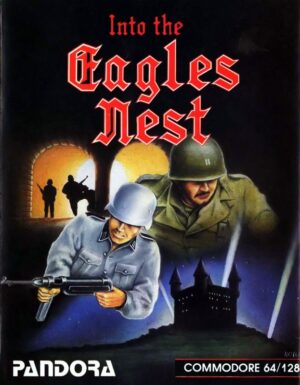Retro Replay Review
Gameplay
Mystery Fun House unfolds entirely through text prompts and a classic two-word command parser, a hallmark of Scott Adams’ adventure series. Players type simple verb-noun combinations—such as “GO NORTH” or “USE KEY”—to interact with the amusement park’s various attractions. The parser may feel rudimentary by modern standards, but it forces you to think carefully about word choice and motivates exploration in a way that more forgiving interfaces sometimes fail to capture.
(HEY YOU!! We hope you enjoy! We try not to run ads. So basically, this is a very expensive hobby running this site. Please consider joining us for updates, forums, and more. Network w/ us to make some cash or friends while retro gaming, and you can win some free retro games for posting. Okay, carry on 👍)
The first challenge—gaining entry past the turnstiles—sets the tone for an experience rooted in observation and inventory management. You must examine the environment, retrieve objects, and experiment with different item combinations to progress. This trial-and-error approach can be exhilarating, particularly when an unexpected action yields a clever solution to a seemingly unsolvable puzzle.
As you delve deeper into the Fun House, each new area presents fresh obstacles: navigating a maze of mirrors, deciphering hidden messages, and outwitting the amusement park’s mysterious overseer. The difficulty ramps up gradually, yet remains fair; hints are often embedded in room descriptions or item names. Patience and persistence are rewarded, making every breakthrough satisfying.
Replay value stems from the delight of rediscovering how each puzzle interconnects within the park’s sprawling layout. Although the core objectives stay the same, veteran players can challenge themselves by solving puzzles in a different order or by attempting a speedrun. For enthusiasts of classic interactive fiction, Mystery Fun House provides a compact but memorable gameplay loop.
Graphics
In its original Western releases, Mystery Fun House adheres to pure text format, relying on evocative descriptions rather than visual assets. This minimalist approach aligns with early home computer constraints and invites your imagination to fill in the gaps—an experience many veteran players find deeply immersive.
However, the Japanese computer editions introduce simple yet charming block graphics that accompany each location description. These rudimentary visuals—drawn in basic pixel art—offer a glimpse of the amusement park’s attractions, from the looming Ferris wheel to the twisting mirror corridors. While not on par with later era standards, they add an extra layer of context to the narrative.
The limited color palettes and static images do not detract from the gameplay; rather, they serve as a nostalgic window into early 1980s home computing. For collectors and aficionados of retro gaming, these regional variants are a delightful novelty that bridges text and graphical adventures.
Overall, whether you experience Mystery Fun House with pure text or with its Japanese graphics, the aesthetic remains consistent with the series’ low-fi charm. The visuals—when present—complement rather than overshadow the core text-based mechanics, preserving the game’s identity as a brain-teasing interactive story.
Story
Set within a deserted amusement park after closing time, Mystery Fun House casts you as an intrepid explorer determined to uncover the park’s secrets. The premise is straightforward: find a way past the turnstiles, navigate the attractions, and solve the titular mystery. Yet within that simplicity lies an engaging sense of wonder.
Each area you visit—be it the House of Mirrors or the bumper car arena—carries its own quirks and hidden dangers. Vague yet evocative descriptions create an atmosphere that balances whimsy with a touch of unease. As you piece together clues scattered throughout the grounds, a subtle narrative emerges, unveiling the reasons behind the park’s eerie abandonment.
Despite its brevity and modest text length, the story progression feels organic. Puzzles double as narrative devices, encouraging you to linger in each location and absorb the setting details. This approach not only heightens immersion but also makes each victory feel like a meaningful step toward solving the greater enigma.
Scott Adams’ signature blend of light-hearted humor and offbeat scenarios shines through in incidental text snippets—whether it’s a cryptic note scrawled on a mirror or a cheeky description of a malfunctioning ride. This tonal balance keeps the experience from feeling overly serious, making Mystery Fun House an enjoyable jaunt for both newcomers and genre veterans.
Overall Experience
Mystery Fun House offers a compact but richly rewarding foray into classic text adventures. Its straightforward puzzles, combined with a playful setting, make it accessible to players curious about the origins of interactive fiction. While modern gamers may miss point-and-click convenience, the game’s minimalist framework cultivates a refreshing focus on language and logic.
The title’s strengths lie in its blend of nostalgic simplicity and inventive puzzle design. Short play sessions can easily stretch into hours as you chase down elusive solutions, making it perfect for those who relish mental challenges. At the same time, the concise scope ensures you won’t feel overwhelmed by sprawling maps or endless inventory lists.
Graphical enhancements in the Japanese versions provide an optional visual treat, but the heart of Mystery Fun House remains its text-based core. If you appreciate the charm of early home computer titles and don’t mind a bit of trial-and-error exploration, this game will likely leave you smiling at every clever twist.
In summary, Mystery Fun House stands as a testament to the enduring appeal of Scott Adams’ pioneering work. Its blend of playful narrative, clever puzzles, and unpretentious presentation make it a worthwhile experience for anyone interested in the roots of adventure gaming.
 Retro Replay Retro Replay gaming reviews, news, emulation, geek stuff and more!
Retro Replay Retro Replay gaming reviews, news, emulation, geek stuff and more!









Reviews
There are no reviews yet.